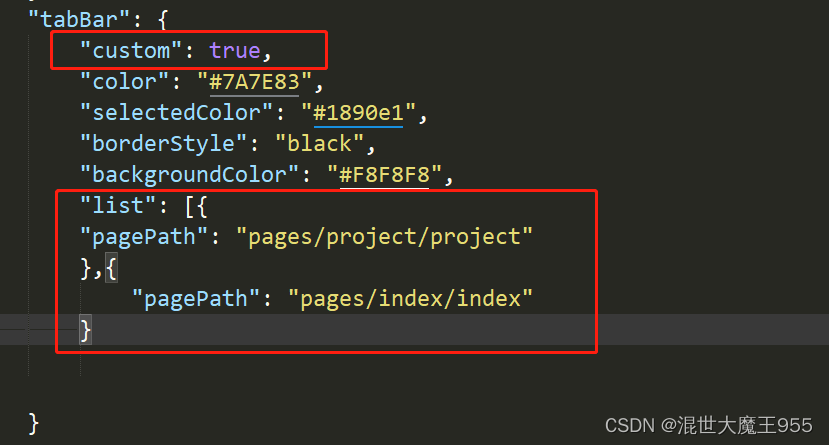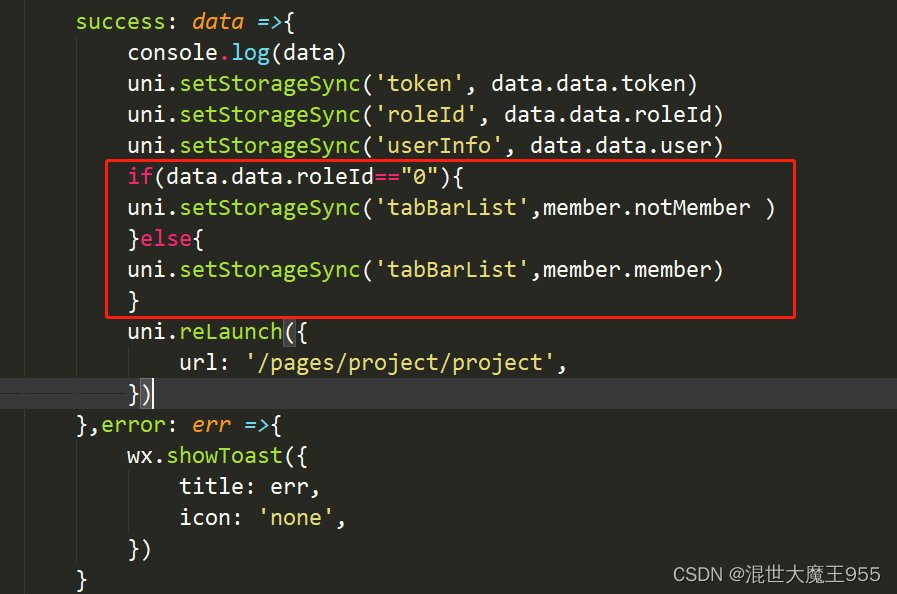uni-app自定义tabBar
目录
一、为什么使用自定义tabBar
目前的业务需求是根据不同的角色展示不同的底部tabBar
二、使用步骤
1.修改pages.json文件
开启自定义组件"custom": true,把list里面只留下页面路径

1.封装组件
<template>
<view class="tab-bar">
<view class="content">
<view class="one-tab" v-for="(item, index) in tabBarList" :key="index" @click="selectTabBar(item.pagePath)">
<view>
<view class="tab-img">
<image v-if="routePath === item.pagePath" class="img" :src="item.selectedIconPath"></image>
<image v-else class="img" :src="item.iconPath"></image>
</view>
</view>
<view v-if="routePath === item.pagePath" class="tit selectTexts">{{ item.text }}</view>
<view v-else class="tit texts">{{ item.text }}</view>
</view>
</view>
</view>
</template>
<script>
export default {
props: {
// 底部导航栏数据
tabBarList: {
type: Array,
required: true
},
// 当前页面路径
routePath: {
type: String,
required: true
}
},
data() {
return {};
},
methods: {
selectTabBar(path) {
this.$emit('onTabBar', path)
}
}
};
</script>
<style lang="scss">
.tab-bar {
position: fixed;
bottom: 0;
left: 0;
width: 100vw;
padding-top: 10rpx;
padding-bottom: calc(10rpx + constant(safe-area-inset-bottom));
padding-bottom: calc(10rpx + env(safe-area-inset-bottom));
background-color: #fff;
.content {
display: flex;
.one-tab {
display: flex;
flex-direction: column;
align-items: center;
width: 50%;
.tab-img {
width: 50rpx;
height: 50rpx;
.img {
width: 100%;
height: 100%;
}
}
.tit {
font-size: 30rpx;
transform: scale(0.7);
}
.selectTexts{
color:#1890e1;
}
.texts{
color: block;
}
}
}
}
</style>
2.tabBar页面引入组件
<tabbar-vue :tabBarList="tabBarList" :routePath="routePath" @onTabBar="onTabBar"></tabbar-vue>
其中tabBarList是底部tabBarList、 routepath是是当前页面的路径、onTabBar是子组件向父组件传递的事件名称
import tabbarVue from '@/components/tabbarVue.vue'引入组件
components: { tabbarVue },注册组件

import member from'@/common/tabBar.js'
common里面定义的不同权限下的tabBar集合
// 管理员
const member = [
{
"pagePath": "pages/project/project",
"iconPath": "/static/default_images/scene.png",
"selectedIconPath": "/static/default_images/select-scene.png",
"text": "场景"
},
{
"pagePath": "pages/index/index",
"iconPath":"/static/default_images/index.png",
"selectedIconPath":"/static/default_images/select-index.png",
"text": "我的"
},
]
// 普通用户
const notMember = [{
"pagePath": "pages/project/project",
"iconPath": "/static/default_images/scene.png",
"selectedIconPath": "/static/default_images/select-scene.png",
"text": "扫码"
},
{
"pagePath": "pages/index/index",
"iconPath":"/static/default_images/index.png",
"selectedIconPath":"/static/default_images/select-index.png",
"text": "我的"
}
]
//抛出供外部调用
export default {
member,
notMember
}3.给子组件传值
let token = uni.getStorageSync("token");
let routes = getCurrentPages(); // 获取当前打开过的页面路由数组
let curRoute = routes[routes.length - 1].route // 获取当前页面路由,也就是最后一个打开的页面路由
this.routePath=curRoute;
//获取缓存里面的tabBar集合
this.tabBarList= uni.getStorageSync("tabBarList");
//没用token返回登录爷
if (!token) {
uni.reLaunch({
url: '/pages/login/login',
})
}4.登录页判断
我这里设有两个权限 0为工作人员 1为管理人员,根据不同的权限判断把tabBar放入缓存中。

5.隐藏原生tabBar
在app.vue里面
onShow: function() {
uni.hideTabBar()
console.log('App Show')
},
自此我的自定义tabBar就完成了